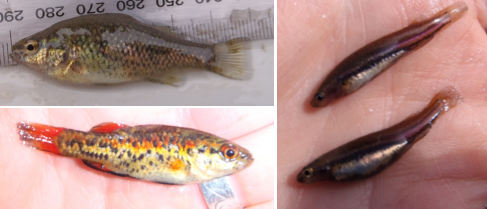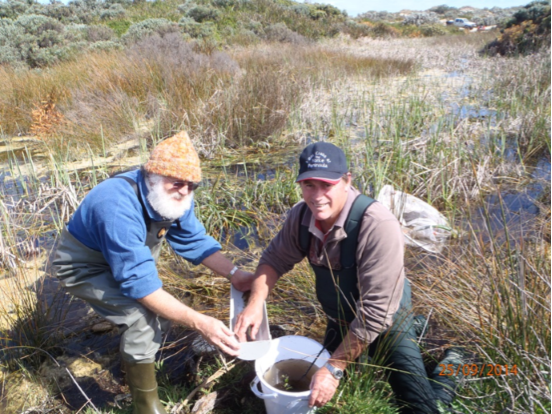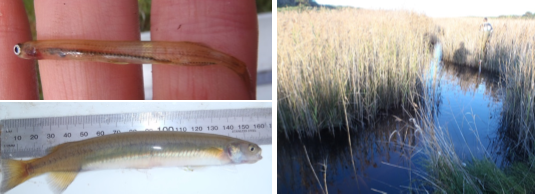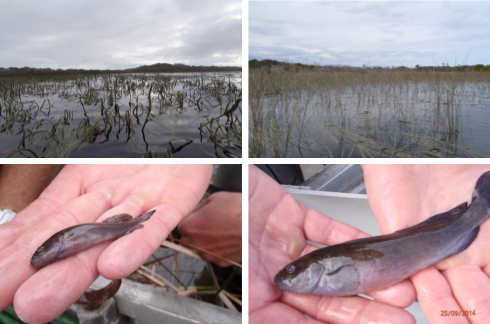Fish monitoring update for Long Swamp
As you will know from the NGT blogs throughout 2014, Long Swamp has undergone the first phases of restoration works to regulate the artificial outlet at Nobles Rocks. While the restoration works to date have resulted in isolated increases in water levels immediately upstream of the structures at Nobles Rocks, the final phase of the restoration trial (to be completed over the coming summer) is expected to have a more significant impact. Restoration ultimately aims to increase the connectivity and availability of aquatic habitat throughout Long Swamp and ultimately support important fauna such as native fish populations.
The first survey of Long Swamp in spring 2012 highlighted that wetland habitat recreated as a result of the natural closure of the second artificial outlet at White Sands, supports a range of fish species, including the nationally threatened dwarf galaxias (Galaxiella pusilla) and Yarra pygmy perch (Nannoperca obscura). Fish monitoring was carried out in autumn and spring of this year to provide an updated assessment of the population status of key native species. This work was completed with the continued (and greatly valued) help of Parks Victoria, who were happy to endure all weather conditions to assist us in accessing some of the more isolated sites.
In total, over 12,000 fish were caught across 15 sampled sites in both autumn and spring. Interestingly, these abundances are significantly greater than the 5,056 fish recorded in the 2012 survey (noting that two additional sites were sampled in 2014). This was mainly due to higher numbers of the common galaxias (Galaxias maculatus) and smallmouthed hardyhead (Atherinosoma microstoma), while the southern pygmy perch continues to be the most abundant species in Long Swamp.
The common galaxias is a diadromous species, meaning that it typically requires both freshwater and marine water to complete its life cycle. In the lead up to winter, mature individuals will migrate from freshwater out into marine/estuarine environments to breed, following which, the juveniles will then migrate back into freshwater during spring. Eel creek, which flows into Oxbow Lake at the mouth of the Glenelg River, acts as an important migratory route for many diadromous species. We were very excited to catch a number of ‘whitebait’ (juvenile common galaxias) at Eel creek last month, as they made their way up into the Long Swamp.
The connectivity between Eel creek and the Glenelg River was further highlighted by the capture of other diadromous species in spring, such as Tupong (Pseudaphritis urvilli) and the shortfinned eel (Anguilla australis), as well as several marine species, e.g. yelloweye mullet (Aldrichetta forsteri) and sea mullet (Mugil cephalus).
During monitoring last month (September 2014), it was pleasing to see many of the larger individuals of key native species (dwarf galaxias, Yarra pygmy perch and southern pygmy perch) in good breeding condition. High numbers of dwarf galaxias were caught in autumn (727 fish) and while fewer numbers were recorded in spring (63 fish), abundances were still far greater than those in 2012 (6 fish). In addition, large numbers of small juvenile dwarf galaxias (too small to be caught by net) were observed in the water at White Sands last month, indicating recent spawning success. While numbers of Yarra pygmy perch were slightly lower in 2014 (compared to 2012), hopefully the presence of mature individuals last month will result in strong recruitment and population recovery in 2015.

Clockwise from top left: Yarra pygmy perch, female dwarf galaxias and male southern pygmy perch, all in breeding condition.
The fish fauna in the recreated habitat at White Sands has undergone considerable change over the last two years, most notably, an increase in abundance of dwarf galaxias and common galaxias. Higher numbers of dwarf galaxias appear to be the result of multiple successful spawning events, while it is unclear what has driven the increases in common galaxias. Lake Moniboeng continues to provide important habitat for several key native species, including Yarra pygmy perch and also River Blackfish (Gadopsis marmoratus).
Since monitoring in 2012, the introduced Mosquito fish (Gambusia holbrookii) has increased in abundance at several sites in Long Swamp. While this population is largely isolated to one area of the wetland, NGT will be joining forces with members from the Australia New Guinea Fish Association later this year to trial some control/eradication techniques.
Overall, Long Swamp continues to maintain an important and diverse fish community, which is expected to further respond to the the next stage of the restoration trial over the coming year. We will back out next autumn to repeat sampling so stay tuned!





